While there are hundreds of articles and publications on time management, a lot of them are concerned with the individual. And while we can improve in managing our own time, that doesn’t necessarily mean we will do just as well when working in a team. Team time management requires a slightly different mindset and approach.
To help you figure out how to track and manage time within a team, we gathered 14 proven tips to get you started. But, before exploring these tips, we’ll first tackle the importance of team time management.
Table of Contents
Why is time management important in a team?
First, we should briefly overview how proper team time management helps the overall workflow and inter-team relations.
Time management reduces stress
Time management is not only crucial to getting things done on time, but it can also decrease the risk of potential health issues. Experts from the Stress Management Society have often warned that poor time management leads to stress. And it’s not just about missed deadlines or staying overtime.
When people have trouble managing their time or find it difficult to prioritize their tasks, they inevitably end up feeling overwhelmed.
Being overwhelmed further causes people to be:
- Nervous,
- Afraid of missing important information or tasks,
- Misreading situations, and so much more.
The brain can then get stuck into panic mode — in which case, the person who responds to the stressful situation — makes mistakes or completely collapses under pressure.
And within a team, different people will react differently to stress caused by poor time management. This situation can further cause inter-team conflict — as person A can accuse person B of being too relaxed, or person B can accuse person A of being too nervous.
So, good time management on a team level can then significantly improve team dynamics and alleviate some of the work stress they face daily.
Time management ensures everyone remains updated
Transparency never went out of style.
However, even with all the apps and services designed to help us keep track of what everyone does at any moment, we’re still mostly in the dark when it comes to our coworkers’ part of the job. Still, communication concerning task progress is vital for the health of a team and the project itself.
But, with improved team time management skills, transparency increases. Prioritizing becomes easier when everyone is tracking what they’re working on and they’re aware of everything that’s on their co-worker’s plate. There’s even less prodding and poking on the group chat to report on progress and certainly fewer meetings.
Once the team starts to track their time collectively, you can start to see the bigger picture more clearly as time goes by. It becomes easier to follow the project progress, and in addition, eliminates the need to ask how everything is going. It is much easier to create reports and hold meetings.
Team members will begin getting an idea of how their time management reflects on the overall project. Their coworkers will also be able to see that and address any problems in due time.
Time management increases project transparency
Transparency is important when managing projects because it makes the team work harder and better. It shows how well a project is performing, builds trust among team members, and keeps work on track.
When the entire team knows their goals and their specific roles, they will function more effectively as a whole.
One way to improve project transparency is to practice proper time management habits that will help you take your project management system to a different level. Effective time management is key to the project’s success, and without it, the team will be left confused and disorganized.
To improve project transparency is by introducing a time tracking software, which will also accelerate project progress. Once the team starts to track their time collectively, you can start to see the bigger picture more clearly as time goes by.
Time tracking makes it easier to:
- Follow the project progress,
- Create reports and hold meetings, and
- Eliminate the need to ask how everything is going.
As soon as they start tracking their time, team members will get an idea of how their time management reflects on the overall project, and address problems in due time.
Furthermore, try to be open with your team about your projects and processes, and create a system where all team members will have easy access to relevant information. Team members are more likely to support each other when they understand what everyone is doing as a whole.
Time management improves collaboration
People are more inclined to help each other when they’re on the same proverbial boat. When a team tracks their time and learns how to manage it together, they will be more likely to help each other out when mistakes happen.
So long as you form a healthy learning environment, your team will become that much better with learning time management.
💡 Clockify Pro Tip
If you want to find out why team collaboration is so important, read our blog post below:
Time management provides a chance to deliver work promptly
Effective time management means that you’re able to finish your tasks on time. This is quite obvious, because if you properly manage your schedule, there is no denying that you’ll meet set deadlines.
But in order to effectively manage your time, you must assign each task a specific time slot.
You can do that with a simple time management technique called time blocking, which allows you to reserve a specific time slot for a task, event or activity in your schedule.
You can also organize tasks based on priority and give enough time to the most important ones.
Or you can break down big projects into smaller units. This will give you an idea of how much time is needed for each task and whether you’ll be able to finish them by the expected due date.
Also, make sure that you leave some extra time, if anything unexpected comes up.
Time management reduces procrastination
Poor time management often leads to procrastination, because it’s very easy to get distracted if you haven’t already set clear goals.
So, make sure to set a clear work routine which will allow you to focus on doing the best work possible and have full control over your schedule. A proper routine helps in minimizing your chances to procrastinate and improves your performance.
When you have a schedule to follow, you’ll find yourself procrastinating less. Instead of postponing your tasks, you’ll be able to focus on what you need to accomplish during a given day. In addition, proper time management will help you avoid tedious tasks and time-consuming distractions, which in turn helps with decreasing downtime.
💡 Clockify Pro Tip
What you do in the morning sets the tone for the entire day. Find out how to live a more balanced life by learning:
How to improve time management in the workplace
One of the best ways to help employees and organizations succeed is to help them organize their time better.
That’s why we decided to cover 14 proven ways that will certainly improve your quality of life, help you limit distractions, and stay focused on deliverables.
Here are some ways to manage your time more effectively.
Tip #1: Track time to see where you’re at
You can start improving your team’s time management by motivating them to track time individually. Everyone needs to be accountable for their own time before they can truly contribute to the whole team’s time management.
For example, in Clockify — a time management app for teams, a team manager can set up projects and important milestones for its progress.
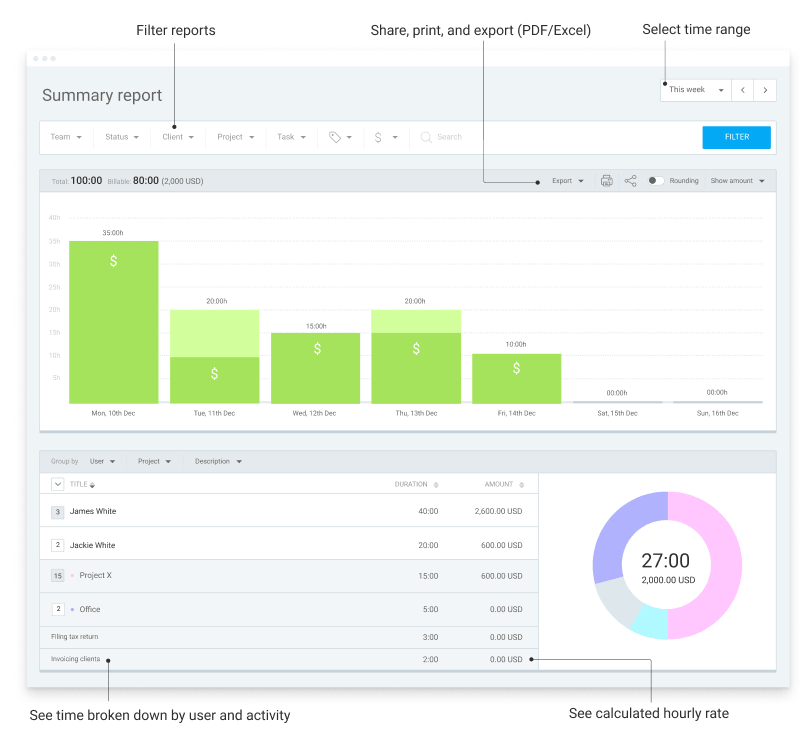
From then on, when each team member tracks the time spent on tasks that contribute to each milestone, the timer will reflect that.
So, how Clockify can help you track time with a team? This guide goes into a step-by-step setup of your team’s workspace, project, and progress report when it comes to time management.
It is also advisable to track time for about two weeks or even a month to learn about your team’s time tracking habits and how they spend their time. This is also the only way to get more information on how each member prefers to manage their time, and how this reflects on the whole team. From that collected data, you can start making changes and improvements.
💡 Clockify Pro Tip
Apart from tracking your team’s time, Clockify can help you gain insight into how much time you spend on specific projects:
Tip #2: Make a workload overview
Being familiar with each team member’s workflow helps with cutting down on unnecessary and time-consuming tasks. So, start by looking into your team’s menial tasks to see which ones are their biggest time investments, and which tasks take the least time to do.
Additional tasks that might increase your team’s workload but are often overlooked are:
- Giving feedback,
- Training new employees,
- Making presentations,
- Organizing meetings,
- Client communication, and
- Emailing.
Start by trimming the fat in those areas first. If both you and the employee notice that certain tasks that are unimportant are taking up more time than necessary, just cut them out.
Take meetings, for example.
Often you will attend meetings that do not concern at least a third of the people present. So, their time and energy are being wasted on listening to conversations that don’t affect them. The same goes for email chains or chat room discussions.
Lastly, while collaboration greatly benefits high-performing teams, keep an eye out for team members who take on other team members’ share of work. If they spend all day putting out small fires and then stay overtime to finish their own tasks, there might be a large imbalance in the workload, and this issue will need to be addressed as soon as possible.
💡 Clockify Pro Tip
Wondering if the team is experiencing wasted time? Here’s a guide that can help you:
Tip #3: Talk to your team
The more you talk to the team, the easier it will be to identify what aspects of time management you need to look into.
Here are some things to focus on when communicating with your team:
- Check what their usual tasks are and what parts of their job can be tedious and taxing,
- Some people are morning larks while others are night owls, so ask them when they feel most/least productive,
- Talk about distractions and identify the most common ones within the team,
- Come up together with strategies that suit their workflow and approach,
- Meet with them every once in a while to ask how their time management has changed or do monthly surveys, and
- Let the team members approach their time management analytically, without micromanagement — so long as they’re in control of their learning progress, the results will be much better.
Since there are no two teams alike, their concerns will differ depending on the department. However, what’s important is to find a common ground and let everyone know they will have an active role in learning how to manage time better. Learning about team time management is more than receiving an informative handout from HR that your team members will inevitably stick in a desk drawer and forget about.
Tip #4: Don’t focus only on work time management
Another useful way to help your team improve their time management skills is to include personal time management. Let the team know that improving their habits at work is good practice that can be of use in their personal life too.
Productivity coach Matt East has presented the easiest way to convince people of the benefits of time management. He believes that answering just ten questions can get people thinking about how they prioritize their time and tasks.
How to prioritize your time and tasks
If you have the opportunity, make a handout with these questions, and have the team mull over them for a day or two. Then discuss their answers to get a better understanding of each other’s priorities.
Here’s what Matt East had in mind and what you should ask yourself if you want to prioritize your time better:
1. If I could achieve one thing today, what would it be?
2. What would be the second most important thing?
3. What would be the third most important thing?
4. What remains to be done after those three things?
5. Which tasks can I delegate to others?
6. What are some other tasks that others are working on and need my attention?
7. What action today will get me closer to my goals
8. What is the one thing that I could complete that would make me feel productive and happy at the end of the day?
9. How will I reduce my stress levels today?
10. Which relationships in my life need the most of my energy today? (work relationship, family, friends, romantic partner, etc)
These questions give a good insight into how people spend their energy, which in turn, affects the way they feel about time and prioritizing. When someone spends an entire morning arguing with their significant other, odds are they will be too drained to focus on a collaborative relationship with their coworkers.
Tip #5 Refrain from doing tedious tasks
At my former company there was a habit of assigning two junior team members to take notes during a meeting. Then we were supposed to compare those notes and write a single report to be distributed to everyone who was at the meeting. As it was explained to us, this was to ensure that all of the information was covered.
However, this habit just doubled the work — we would compare notes, then my coworker would email their bullet points to me, I’d add what was missing (or vice versa), and then I would format it and send it to everyone.
Only after an hour were we able to continue with our regular work, since both of us were occupied with a task one person could do.
Certain tasks like writing reports and taking notes cannot be entirely eliminated, but luckily you can simplify the process as much as you can, and as often as possible.
The longer the employees are occupied with menial, unimportant tasks, the more time they spend away from what they really should be doing.
Tip #6: Step outside the box when managing time
Your team can’t be successful if you’re using the same formula over and over again. In an article from Harvard Business Review, on the topic of managing collective time, author Leslie Perlow offered an insightful idea on innovating with time management techniques.
She reported on tried-and-true practices of numerous companies offering time off to see how it would reflect on the project’s progress and overall workflow.
Let’s go over some examples:
- In companies that were plagued by the “always-on” hustle culture, employees valued a night off to recharge and dedicate some time to their personal lives. The additional time helped people de-stress.
- Companies with teams that tended to deliver tasks on time with little problem saw this time off as a reward for hard work. In their case, they saw it as recognition of their efforts.
- And for companies whose teams were overwhelmed by meetings, inter-team (and outside) distractions, employees were able to get alone time outside the bustling office. They found it easier to finish tasks or catch up.
The novelty of introducing a time-off afternoon or morning during a weekday can be beneficial for both employees and managers. This way, teams learn how to cooperate better and manage their time around these breaks.
You can do the same by, for example, offering an early workday end on Friday to help boost productivity that normally drops before the weekend. Or you could introduce clocking out early on Wednesdays which is just in the middle of the week and tends to feel like the longest day.
Tip #7: Raise awareness of deadlines
No one likes deadlines. It’s a fact.
However, when we think about it, we are all fine with deadlines the moment we set them. There’s a sense that we still have things under control and we can finish our tasks on time. The moment we start hating the deadlines is when they inevitably approach, and we still aren’t near the finish line.
So it’s safe to say that our relationship with deadlines depends on our awareness of them.
To help your team manage their priorities better try keeping a constant visible reminder of the project’s progress and deadlines. However, none of it should be imposing and frightening. Rather, go for an informative graph on a wall-mounted screen or a simple milestone tracker written on a whiteboard.
This way, you’ll help people become more aware of their time framework and limitations. Digital kanban boards and trackers are easy to ignore if people have to access them on their own computers. But, when deadlines are clearly visible, they are less likely to “sneak up on” anyone.
Tip #8: Offer help when needed
Research from the experts at McKinsey suggests an interesting viewpoint — nowadays, time management is less of an individual issue and more of an institutional one. The research also points out that people who see themselves as great time managers have great support in scheduling and allocating their time.
In this study, they listed an example of an administrative assistant who helped the CEO’s scheduling by asking them:
- Whether they’ve met with certain clients,
- If they should follow up with another company on a more regular basis, and
- If certain priorities are set properly according to the company’s current objectives.
On a smaller scale, a manager can do the same for their team. They can meet with the team and see where their efforts and time can be refocused. As time goes by, everyone’s priorities will change.
For example, maybe the development of a new tool’s website can be moved further behind because new prospective stakeholders would like to see the complete version of the tool. Or the beta testing showed that the actual user base isn’t mid-sized companies but freelancers, so there will be a need to reevaluate the marketing strategy.
Change your mindset from individual time tracking to one that reflects the project, product, and team’s efforts. Managers have the luxury to see the bigger picture, and this is precisely why they need to guide their team through changes and help them manage their time better.
Tip #9: Set down some common rules
As with every team, people will cooperate but also clash. They might have trouble communicating or they might even be on the lookout for each other’s mistakes. Frustrations like these, however, can lead to situations that can harm your team’s time management.
Also, things like in-person distractions, poorly communicated tasks and feedback, and lack of transparency — can all cause a team to start breaking at the seams, one frustration at a time.
And while you can let them iron out their habits over time, for coworkers to truly start managing their time as a team, they need a set of agreed-upon rules to their peace of mind.
Come up with a solid communication etiquette
Introduce a codified way of discussing project issues, tasks, and progress. For example:
- If something needs to be addressed within the next 24 hours, send an email.
- If something requires your attention within the next hour or two, send a chat message.
- If the issue is urgent and can’t wait, send a text message or call.
Far too much time is wasted when unimportant things are discussed over email or when urgent tasks are overlooked because a person’s chat is constantly pinging. However, by setting communication ground rules, you’ll ensure that each notification has an established timeframe and the recipient will know if they should address it now or if it can wait.
This habit further eliminates interruptions and distractions.
Introduce codes for uninterrupted work time
Most of the time employees need focused uninterrupted time. Although setting aside a couple of hours for focused work might not be possible at all times, it’s necessary to ensure employees are able to work in a distraction-free environment at least from time to time.
💡 Clockify Pro Tip
There’s no one specific answer for how to improve focus, so here are 20 practical ways to do so:
For example, a customer service agent can message the head of marketing to ask about a feature a user is inquiring about. However, if the head of marketing is currently writing an important email, they risk sounding rude when they turn down the customer service rep. Or one developer might need feedback on a bug in the code, while their colleague who’s supposed to provide feedback is busy trying to fix their own issues they’ve found.
In cases like these, it’s useful to have a universal “do not disturb” code. These can be anything from:
- Red post-it notes on their computer screen, to
- Actual do-not-disturb signs on their desks.
The team simply needs to agree on a code, and respect the boundaries that come with it.
Tip #10: Reduce sudden meetings
Not every decision or issue needs a meeting room and hours of discussion. Too many meetings per week can throw teams’ time management off balance, especially when a manager schedules a meeting to discuss an unexpected thing that has just come up.
But, when and how should you actually hold a meeting?
- Schedule a meeting after hitting a specific milestone/deadline. This is to ensure you are still on the right course and address any changes that need to be made. However, if you want to give feedback on the progress the team’s made thus far, keep it either very brief or save it for emails or 1:1 meetings with members.
- Make a meeting schedule and stick to it. Every meeting should have an agenda with the main points to address and follow-up questions or discussions. Take some time before every meeting to create a bulleted list of topics and email them to the whole team. This way everyone will stay focused during the meeting.
- Streamline the meeting conversation. Don’t let people derail the topics with arguments, disagreements, or lighthearted chatter. Brainstorming is okay, as long as brainstorming was the reason behind booking the meeting.
- Announce the meetings in a timely manner. Unplanned meetings can ruin every employee’s focus. One moment they’re at their desk, working, and the very next they’re required to shift their attention to a completely new thing. This is known as ‘switching costs’ (which consists of two stages — goal shifting and rule activation) and can help people switch between tasks.
It’s important to make meetings more productive because they greatly affect employee productivity. Whenever your team needs to attend a meeting that lacks proper schedule or purpose you risk all your time management efforts potentially failing.
Tip #11: Use proven time management techniques
Nowadays we all hunt for the best strategies to help us learn better time management. And while the majority of time management techniques deal with the individual, the two of the most famous techniques can also be used to improve time management skills in larger groups.
Here’s how the Eisenhower matrix and time blocking can be applied to team development.
The Eisenhower matrix
The Eisenhower matrix is a hailed method of time management that helps productivity and efficiency through teaching proper prioritization.
We’re all aware of the fact that not all tasks are equally important and urgent, and that’s exactly what this time management method is all about.
The Eisenhower matrix recognizes four categorizations:
- Tasks that are important and urgent — tasks scheduled for tomorrow, for example,
- Tasks that are important, but not urgent — writing up a progress report for next week,
- Tasks that are unimportant, and urgent — setting up a last-minute meeting for the next week, and
- Tasks that are unimportant, and not urgent — deleting old files from the team’s cloud storage.
For a clearer overview, the matrix is often presented in four quadrants. So, for example, a customer support team could create an Eisenhower matrix that looks like this:
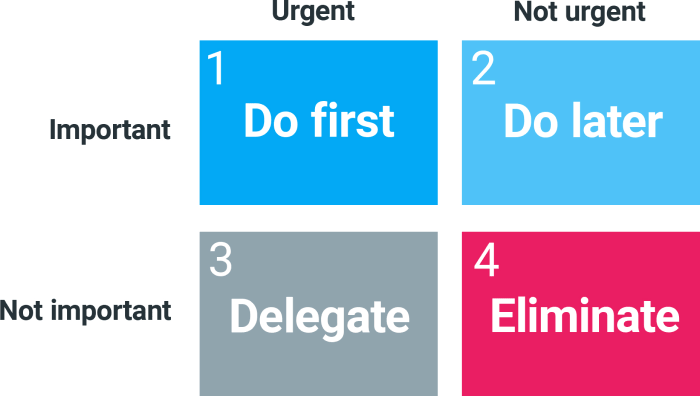
By following the schematics, you can formulate your own team’s matrix with ease. If possible, try to schedule a brainstorming meeting where all team members can participate in the matrix’s creation. Remember, when employees are given more agency in their collective time management they are more likely to follow through and learn more quickly.

💡 Clockify Pro Tip
For more detailed instructions on how to make the Eisenhower matrix work, you can take a look at the following guide:
Time blocking
How do you balance between meetings, emails, deadlines and personal life? You need a concise strategy to help you focus and time blocking is one of them — the second highly effective time management technique.
This technique helps keep the work throughout the day flowing by having you schedule your day (or week) in advance. Time blocking includes:
- Setting the tasks for the day on paper,
- Writing down how much time each task would take,
- Scheduling tasks in your calendar, and in that way,
- Creating time blocks.
Once you start working in time blocks, the point is to stick to the allotted time and avoid tasks seeping into other time slots. This way, you’ll ensure that you’re focused on one thing at a time, while not forgetting other tasks. Time blocking is also an effective tool if you’re looking for a way to prevent working overtime.
Also, setting up a time blocking system to schedule your day couldn’t be easier, especially for teams. For example, you can connect the Clockify extension with your Google calendar and as soon as a time slot pops up, you simply start the timer without leaving your browser or opening a new app.
If you’d like to adapt this technique to benefit your team time management try setting time blocks for important tasks that need to be delivered that day. The team members can check off those tasks as they are finished, and by the end of the day, you’ll have a clear overview of everything that was done.
The Eisenhower matrix is also great for identifying issues with time management individually before they start to affect the team on a larger scale.
💡 Clockify Pro Tip
For more resources and other time management techniques, you can find information here:
Tip #12: Introduce team time management tools
Now, we can’t forget that time management also requires some help from the outside. Apps, platforms, services, and software are all there to aid struggling individuals and teams. They’re also used for analysis, improvement, and even as shortcuts for eliminating menial tasks.
Here are some of our favorites.
Clockify — best for team time tracking

We may be biased here, but Clockify really is a multi-faceted tool.
What’s more, it can be used both in the office and offsite, making it a great software for companies with hybrid and remote work policies.
Although it is mainly a work hours tracker, Clockify can also help you:
- Create work estimates,
- Create project progress reports,
- Track habits, activities, and work locations,
- Keep track of who’s doing what,
- Identify wasted time, and
- Bill clients.
Moreover, the time tracking software also integrates with 80+ project management, team collaboration, and productivity tools, which means that everything you enter can be synced with other business tools your team regularly uses.
Therefore, Clockify quickly becomes a handy asset for every manager and team looking to improve their time management.
Notion — best for lists and basic task management
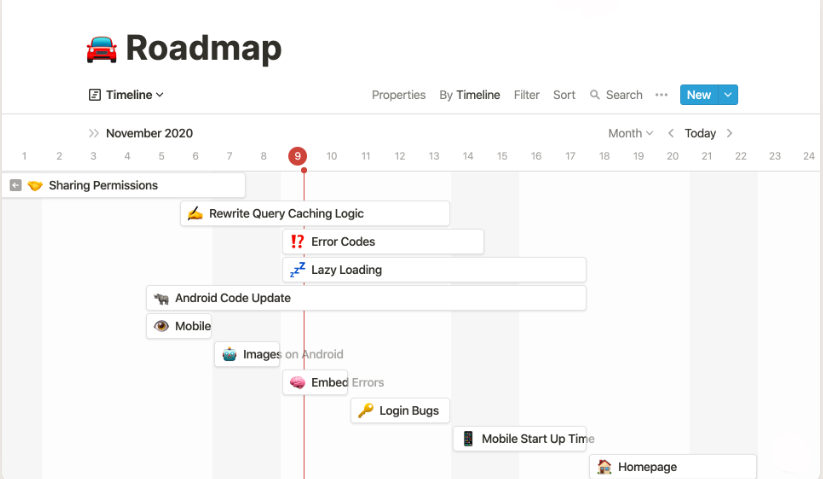
Another invaluable app is Notion — a platform with a robust list of features that works like several tools in one. This software is:
- A document archive,
- A project management board, and
- A task-overview platform.
Therefore, it offers a very versatile workspace that can replace many tools that serve a single function.
Notion also features integrated chat, a Wiki, and much more. When all your information and progress are stored in one place, there’s no need to waste time circling through various different apps.
Pumble — best for team communication
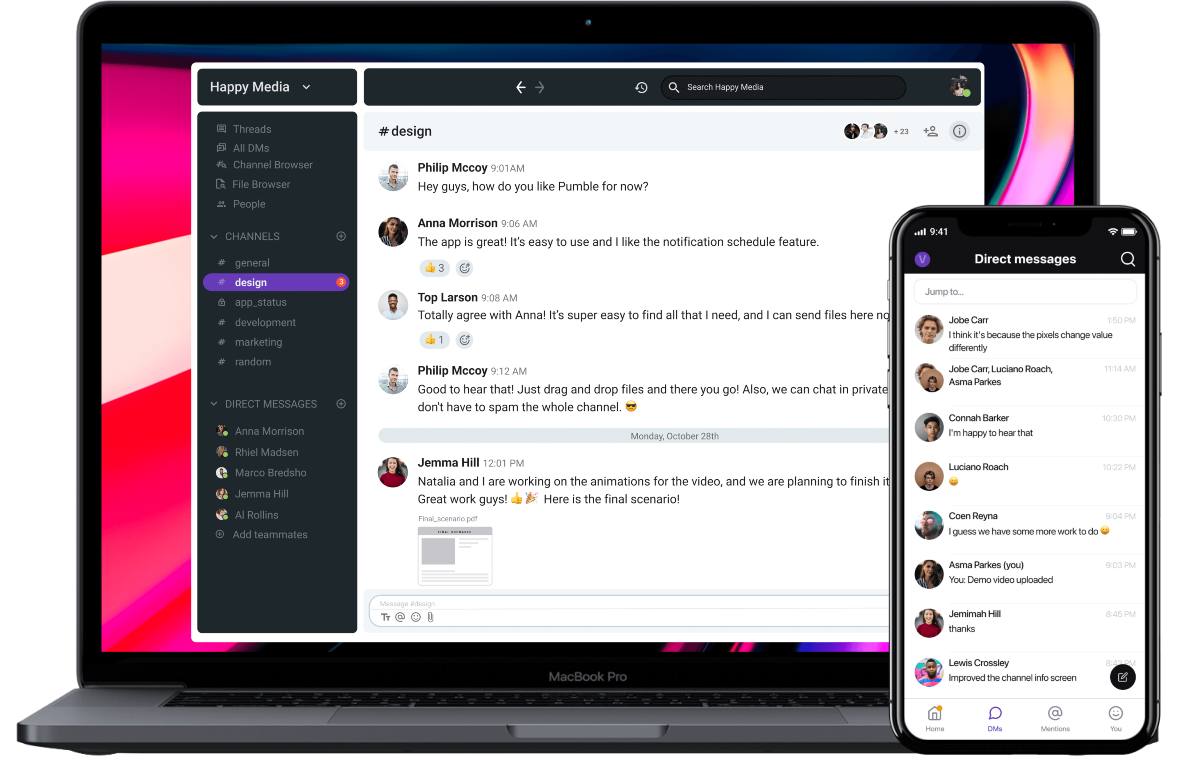
Pumble is an affordable collaboration and communication tool meant to help businesses and individuals chat instantly with team members across different departments and locations. This tool makes it easy to communicate with coworkers because it works across multiple devices and platforms.
With Pumble you can:
- Make audio and video calls,
- Create public or private channels,
- Organize conversations via threads,
- Chat with team members via direct messages,
- Share files, links and images,
- Adjust permissions and notifications,
- Personalize your profile, and much more.
Pumble is easy to use, quite affordable, and, most importantly, it offers tight security. All of these factors make it a great messaging platform that will help your team communicate better.
Plaky — best for team task management
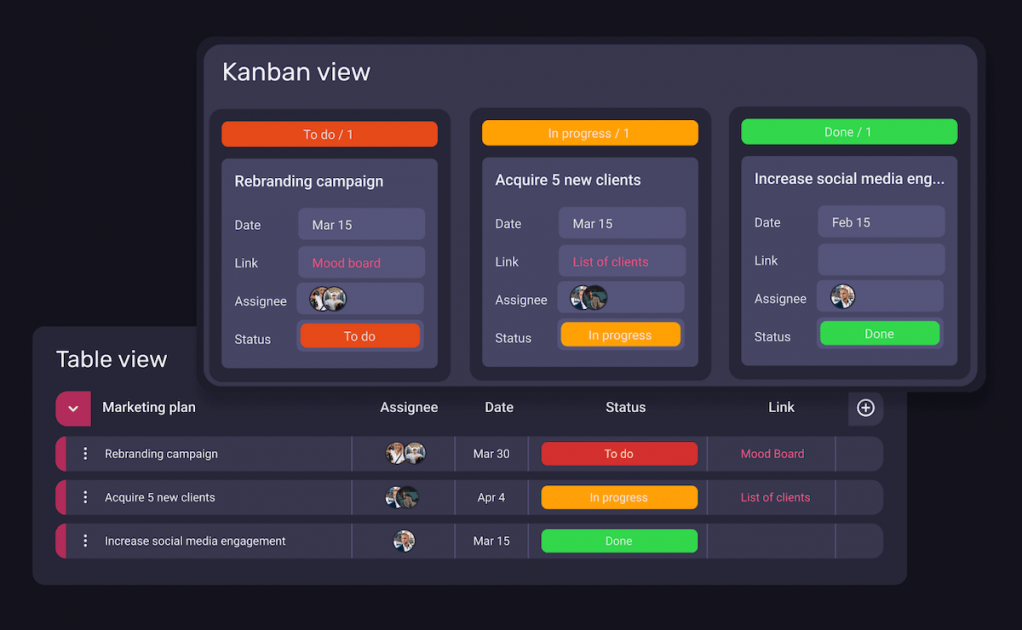
Plaky is a free task and project management software that allows you to create multiple tasks and projects in one single dashboard.
With Plaky, you can:
- Create to-do lists,
- Assign tasks to team members,
- Organize tasks based on different stages and departments,
- Add task information,
- Share files and documents, and
- Make comments about specific tasks.
When a teammate makes any changes and updates or assigns tasks, you’ll immediately get notified by email.
What’s more, you can integrate Plaky with Clockify in order to track time on your tasks and projects.
Finally, you can have all 3 apps — Clockify, Pumble, and Plaky — at a very special bundle price and save 53% on subscriptions.
Otter — best for recording meetings
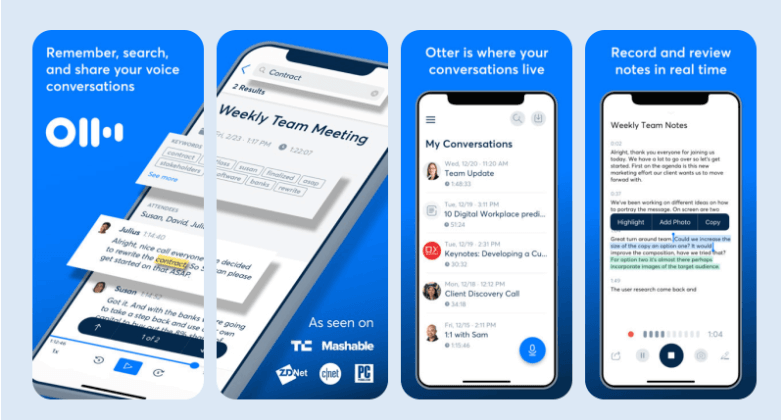
Tools like audio recorders can save you additional time. Otter lets you record any audio be it:
- An entire meeting,
- Feedback, or
- Instructions
Then you will be able to transcribe it into a document in a matter of minutes. So not only can you share the audio itself, but you can also dictate what you need to get across and receive an automatically written form on the other end. The tool is also integrated with Zoom, so you can even record video calls.
Evernote — best for taking notes
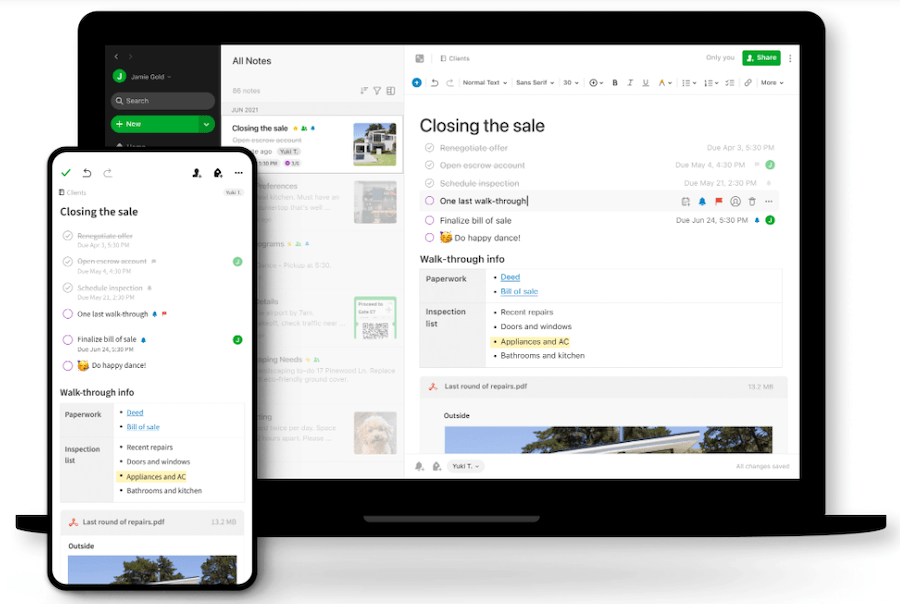
Will this note-taking app really save you time? Accessing and organizing your ideas, projects, and to-do lists has never been easier. Evernote is super simple to use, syncs across all devices, and displays ample functionalities that will definitely tame and organize your schedule.
Let’s see the main attributes that Evernote offers:
- Scan in handwritten ink notes,
- Web clipper browser extension,
- Access to multiple templates,
- Text search in documents,
- Record audio notes, and
- Offline access to documents.
You can arrange pieces of formatted text, photos, videos, voice memos, or file attachments into separate folders (notebooks) and then comment, edit, add unique tags, and annotate them. These features can save you a lot of valuable time and effort.
Tip #13: Enhance team collaboration
Promoting team collaboration is also another way of improving team time management, productivity, and overall performance. Employees work together towards achieving a common goal, therefore it’s important to set up a collaborative work environment.
Everyone on the team would benefit from using communication and collaboration tools that let you:
- Instantly message coworkers,
- Hold online meetings and video conferencing,
- Share files and documents,
- Post questions and comments,
- Share ideas with group members,
- Receive feedback about completed work, etc.
Collaborative workspaces appear trustworthy, engaging, and more productive. However, despite the known benefits of team collaboration, many managers need help with integrating collaborative tools in the workspace. However, it’s never too late to support your team by trying out different tools and seeing what works best.
If you’d like to ensure your team collaboration runs smoothly, try going for a team chat app that can help you communicate with your team members more effectively.
Tip #14: Get rid of handwritten notes
If you’re still tackling your projects by hand, you’re probably losing hours of your precious time, so you might want to consider streamlining your workflow and investing in a project management tool.
In fact, written to-do lists can be highly disorganized and hectic. What’s more, they can easily get lost between the piles of paper.
Fortunately, there are tons of project management tools that can help your team use their time more effectively.
The majority of these tools provide a valuable feature set and let you:
- Break down projects into manageable tasks and subtasks,
- Track real-time performance from start to finish,
- Stay informed about deadlines in order to achieve set goals,
- Communicate about projects, adjust project status, and get feedback.
Project management software can help your team remain on the same page and keep progress on schedule as expected, because managing projects — especially complex ones — is a difficult task.
Improve your team’s time management and overall workflow with Clockify
Helping your team master time management skills is essential for your organization. On top of helping you and your team reduce the overall time needed to deliver work, better time management skills also benefit team collaboration.
In fact, with the right time tracking tool, you can not only track how you and your team spend time but also help your team reduce procrastination and work more efficiently.
Clockify can help you with all of this.
With its time tracking features, Clockify allows your team members to track the time they spend on their tasks and projects. That way, they can see how long it takes them to complete each task.
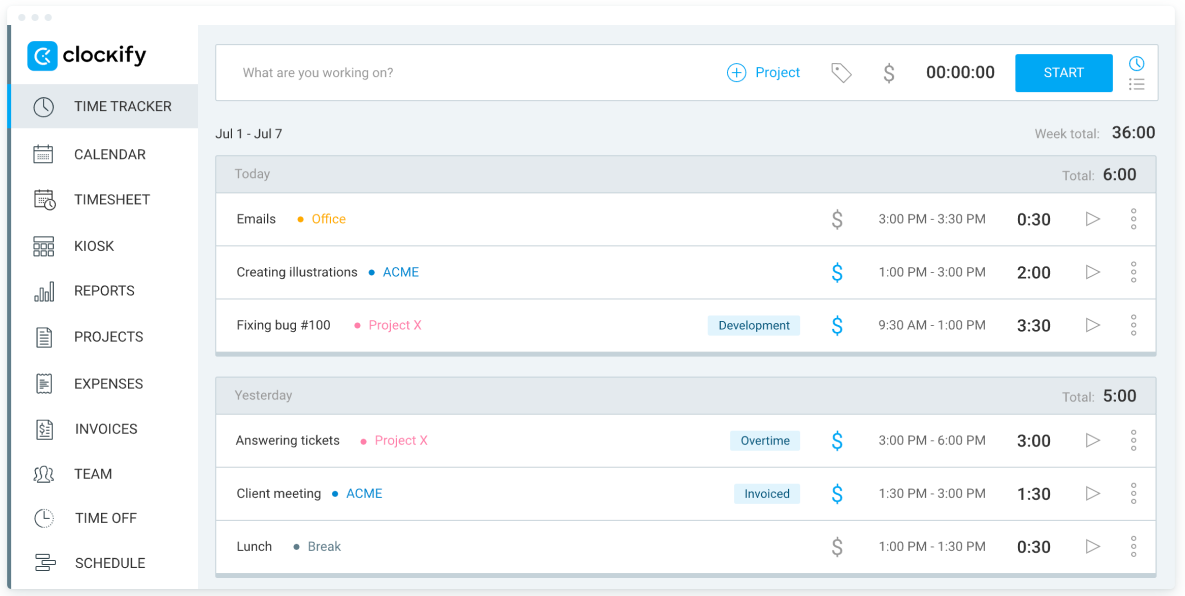
When each team member gains better insight into how they spend their time, it will contribute to better time management for the entire team.
You can also see your team’s activities and identify their productive and unproductive habits in Clockify’s Dashboard.

Clockify also allows you to analyze your team’s tracked time in Reports, schedule and assign tasks to your team, and more — so try it now.



